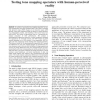Free Online Productivity Tools
i2Speak
i2Symbol
i2OCR
iTex2Img
iWeb2Print
iWeb2Shot
i2Type
iPdf2Split
iPdf2Merge
i2Bopomofo
i2Arabic
i2Style
i2Image
i2PDF
iLatex2Rtf
Sci2ools
134
click to vote
JEI
2007
2007
Testing tone mapping operators with human-perceived reality
Abstract. A number of successful tone mapping operators for contrast compression have been proposed due to the need to visualize high dynamic range (HDR) images on low dynamic range (LDR) devices. They were inspired by fields as diverse as image processing, photographic practice, and modeling of the human visual systems (HVS). The variety of approaches calls for a systematic perceptual evaluation of their performance. We conduct a psychophysical experiment based on a direct comparison between the appearance of real-world scenes and HDR images of these scenes displayed on an LDR monitor. In our experiment, HDR images are tone mapped by seven existing tone mapping operators. The primary interest of this psychophysical experiment is to assess the differences in how tone mapped images are perceived by human observers and to find out which attributes of image appearance account for these differences when tone mapped images are compared directly with their corresponding real-world scenes r...
Related Content
| Added | 15 Dec 2010 |
| Updated | 15 Dec 2010 |
| Type | Journal |
| Year | 2007 |
| Where | JEI |
| Authors | Akiko Yoshida, Volker Blanz, Karol Myszkowski, Hans-Peter Seidel |
Comments (0)

